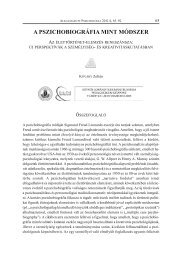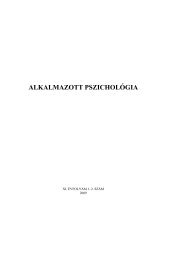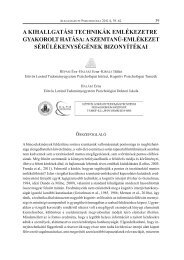letöltése (PDF) - Alkalmazott Pszichológia - Eötvös Loránd ...
letöltése (PDF) - Alkalmazott Pszichológia - Eötvös Loránd ...
letöltése (PDF) - Alkalmazott Pszichológia - Eötvös Loránd ...
You also want an ePaper? Increase the reach of your titles
YUMPU automatically turns print PDFs into web optimized ePapers that Google loves.
16 PATAKY Nóra–KÖRMENDI Attila<br />
nél kül nem vár ha tunk po zi tív vál to zá so kat. A vo ná sok sta bil nak bi zo nyul nak a gyer mek kor -<br />
ból ser dü lő kor ba tör té nő át me net fo lya mán, a ser dü lő kort kö ve tő en, de már a ser dü lő kor alatt<br />
sem szá mít ha tunk vál to zás ra. Frick (1998) a C/U vo ná so kat a fel nőtt ko ri pszi cho pá tia<br />
prekurzorának te kin ti. A ko rai iden ti fi ká ció és a ke ze lé sek fon tos sá ga mel lett szól, hogy gyer -<br />
mek- és ser dü lő kor ban a C/U vo ná sok je len lé te komp lex te rá pi ás mód sze rek al kal ma zá sá val<br />
a tü ne tek kis mér té kű csök ke né sé re szá mít ha tunk (Hawes és Dadds, 2005), míg a fel nőtt ko ri<br />
pszi cho pá tia ha té kony ke ze lé se még nem meg ol dott (Harries és Rice, 2006).<br />
5. Több em pi ri kus ku ta tás ra len ne szük ség Ma gyar or szá gon is a C/U vo ná sok kal kap cso la -<br />
to san. A szü lők szá má ra nagy se gít sé get je len te ne a spe ci á lis in ter ven ci ós, il let ve szü lői ne -<br />
ve lé si stra té gi ák meg fo gal ma zá sa. Fel té te lez he tő en a C/U vo ná sok je len lé te ese tén a ju ta lom -<br />
ori en tá ció és a bün te tés irán ti ér zé ket len ség mi att el ső sor ban a po zi tív ne ve lé si tech ni kák tól<br />
vár ha tunk ered mé nye ket.<br />
SUMMARY<br />
CONNECTION BETWEEN DISCIPLINE STYLE AND<br />
CALLOUS/UNEMOTIONAL TRAITS AMONG CHILDREN AND ADOLESCENTS<br />
Callous/unemotional traits means an unique affective (eg. lack of guilt, shallow emotions)<br />
and interpersonal (eg. proactive aggression, failure to accept responsibility) style which<br />
appears on early ages and is relatively stable across childhood and adolescence. Recent<br />
results suggest that the presence of callous/unemotional traits determine a special subgroup<br />
of aggressive, conduct disorder children which shows high resistance toward discipline<br />
strategies. Resistance against positive changes of discipline style of parents can be partly<br />
explained with some tem pe ra ment characteristics and disturbances in emotion processing of<br />
callous/unemotional children (e.g. lack of eye contact, reward dominance or fearless). Our<br />
article introduce the agression behavior pattern of callous/unemotional children. Based on<br />
previous researches we analyze the affect of temperamental characteristics and disturbances<br />
in emotion processing on the appearance of agressive behavior with caloous/unemotional<br />
children and adolescents. Finally we introduce some discipline methods wchich can be useful<br />
beside the mentioned temperamental characteristics and disturbed emotion processing.<br />
Further empirical researches need to reinforce efficiancy of mentioned discipline strategies.<br />
IRO DA LOM<br />
ADOLPHS, R., GOSSELIN, F., BUCHANAN, T. W. (2005): A mechanism for impaired fear<br />
recognition after amygdala damage. Nature, 433. 68–72.<br />
ANDERSHED, H., GUSTAFSON, S. B., KERR, M., STAFFIN, H. (2002): The usefulness of selfreported<br />
psychopathy-like traits in the study of antisocial behavior among non-referred<br />
adolescents. European Jo ur nal of Personality, 16. 383–402.








